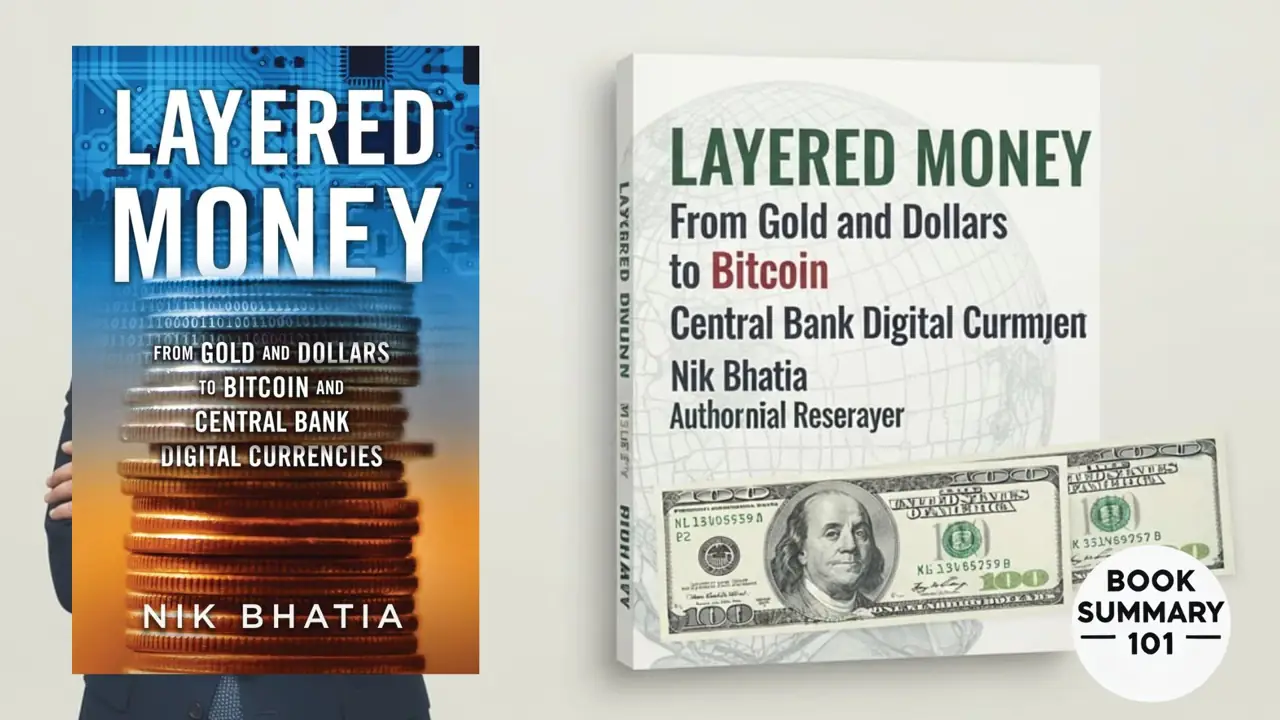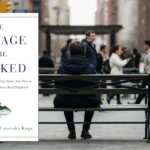Money runs our world — yet few of us truly understand how it works. In “Layered Money: From Gold and Dollars to Bitcoin and Central Bank Digital Currencies”, author and financial researcher Nik Bhatia pulls back the curtain on the complex layers that make up our global financial system. He traces money’s journey from gold coins to digital assets, revealing how trust, not metal or paper, is the real foundation of value.
If you’ve ever wondered how money actually flows, why Bitcoin matters, or what central bank digital currencies (CBDCs) could mean for the future — this is your roadmap. Let’s explore what makes this book such an eye-opening read.
💬 Why Read This Book?
Because understanding money means understanding power.
“Layered Money” isn’t just for economists or crypto enthusiasts — it’s for anyone curious about how trust, technology, and policy shape our financial world. Bhatia’s biggest gift is clarity. He makes a complex topic feel surprisingly approachable, showing you that money isn’t some mysterious force — it’s a man-made system built on belief.
If you’ve ever felt overwhelmed by financial jargon or skeptical about cryptocurrencies, this book simplifies it all. It bridges the gap between the traditional world of banking and the digital frontier of blockchain.
In short: this book helps you think about money differently — as layers of trust, innovation, and human behavior.
The Foundation – Money as Layers of Trust
Bhatia begins with a simple but powerful metaphor: money is layered. Think of it as a pyramid, where each level builds upon the trust of the one beneath it.
- Layer 1: The foundation — historically, this was gold, the physical asset everyone agreed had value. Today, it’s the central bank reserves or the ultimate “trust anchor” in the financial world.
- Layer 2: This includes commercial bank money — the dollars in your checking account that are promises built on the reserves held by banks.
- Layer 3: The outermost layer — credit, securities, digital money, and crypto assets — where innovation and risk explode.
Each layer represents a promise. And like any tower of promises, if one weakens, everything above it shakes. Bhatia’s insight helps us see money not as “things,” but as a web of trust relationships between people, banks, and institutions.
This layered perspective completely shifts how we understand value — from something owned to something owed.
From Gold to Dollars – The Age of Central Banks
Once upon a time, gold ruled the world. Every major currency was tied to it, and people trusted gold because it was scarce, tangible, and universally accepted. But as economies grew and trade exploded, gold became too rigid to keep up.
Enter central banks — the new custodians of trust. The Bretton Woods Agreement (1944) placed the U.S. dollar at the center of global finance, backed by gold. But when Nixon ended the gold standard in 1971, money officially became fiat — valuable only because governments said so.
Bhatia calls this the moment money became “abstract trust.”
No longer a physical commodity, money became a promise — backed by laws, policy, and the authority of nations.
This transition gave the world flexibility but also sowed the seeds of future instability. After all, if money can be created by decree, what happens to the meaning of value?
The Cracks in the System – Lessons from Financial Crises
Bhatia doesn’t shy away from showing where this trust-based system has failed.
The 2008 Global Financial Crisis is his prime example. When banks lost faith in each other’s ability to repay, the layers of money began collapsing. The credit markets froze, panic spread, and central banks had to step in with massive bailouts.
In Bhatia’s view, this event exposed the fragility of layered trust.
When the middle layers — commercial banks and financial institutions — break, the entire monetary pyramid teeters. It reminded the world that money isn’t as stable as it looks; it’s built on confidence, and confidence is emotional, not mathematical.
This is where the story pivots to something revolutionary — a new kind of money that doesn’t depend on human trust at all.
The Rise of Bitcoin – A New Layer of Decentralized Trust
Enter Bitcoin — the digital alternative that rewrites the rules of money.
Bhatia describes Bitcoin not as a rebellion but as an evolution — a new layer of trust built on mathematics, not governments.
Unlike traditional money, Bitcoin isn’t issued by a central bank. It’s created through mining — a decentralized process that verifies transactions through cryptography.
This makes it trustless, meaning you don’t need a middleman to prove ownership or authenticity.
For the first time in history, we have a monetary system run by code.
No human manipulation. No political interference. Just transparent, algorithmic fairness.
Bhatia argues that Bitcoin could serve as the Layer 1 of the digital world — the “digital gold” upon which new financial systems can be built.
It may not replace fiat money but could coexist as a parallel layer, offering security against inflation and corruption.
The Future – Central Bank Digital Currencies (CBDCs) and the Hybrid Era
Just when you think you’ve caught up, Bhatia introduces the next revolution: Central Bank Digital Currencies (CBDCs).
These are government-backed digital currencies that merge the authority of central banks with the efficiency of blockchain technology.
CBDCs could redefine how we use money — imagine instant payments, programmable salaries, and smart contracts built directly into your wallet.
But they also raise big questions about privacy and control.
If every transaction is traceable, who really owns your financial freedom?
Bhatia envisions a hybrid financial future, where Bitcoin, CBDCs, stablecoins, and traditional money all coexist.
The layers of money are multiplying — but so are the layers of complexity and potential risk.
The key takeaway?
The future of money isn’t about replacing the old — it’s about integrating the new.
Real-Life Examples
Nik Bhatia uses real-world stories and analogies to make these abstract ideas come alive — and they stick with you long after you close the book.
- The Gold Standard’s Collapse (1971): Bhatia recounts how President Nixon’s decision to abandon gold backing wasn’t just political — it was psychological. It marked humanity’s full leap into trust-based money, forcing everyone to believe in something they couldn’t touch.
- The 2008 Financial Crisis: Through vivid storytelling, he shows how “money froze” when banks stopped trusting each other. The crisis wasn’t just about bad loans — it was about a collapse in belief. This event laid the foundation for Bitcoin’s rise.
- Bitcoin’s Creation (2009): Bhatia connects the dots between 2008 and Bitcoin’s white paper. Satoshi Nakamoto didn’t just invent digital currency — he offered an alternative trust system at a time when people’s faith in banks was shattered.
- China’s Digital Yuan: Bhatia dives into how China’s CBDC experiment is a glimpse of the future — where governments wield digital control over currency flows. It’s efficient but raises ethical questions about surveillance and individual liberty.
- Modern Banking Layers: He illustrates how the money in your bank account isn’t “yours” in the purest sense — it’s a liability on someone else’s balance sheet. This realization changes how readers think about financial security.
Each of these examples shows that money isn’t static — it’s alive, adapting to crises, innovations, and human behavior.
Join the Conversation!
Money is changing — again. Whether you’re excited by Bitcoin or skeptical of digital currencies, “Layered Money” challenges you to think deeper about where your trust lies.
So, what do you think?
Are we heading toward freedom through decentralization — or deeper control through digital money?
Let’s talk about it below
5 powerful quotes from Layered Money: From Gold and Dollars to Bitcoin and Central Bank Digital Currencies by Nik Bhatia
📖 “Money is a hierarchy of promises, built on layers of trust.”
Meaning: This quote captures the book’s central idea — money isn’t just coins or numbers in your account; it’s a system of relationships where each layer (from gold to cash to credit) depends on trust in the one below it.
In simple terms: Money works because we believe it will — it’s a network of promises that only functions when we trust it.
📖 “Bitcoin didn’t destroy trust; it redefined where trust lives.”
Meaning: Bhatia argues that Bitcoin isn’t anti-trust — it simply moves trust from institutions (like banks and governments) to mathematics and decentralized consensus.
In simple terms: Bitcoin shifts trust from people to code — it’s not about removing trust but changing who we trust.
📖 “The dollar replaced gold not because it was better, but because people trusted it more.”
Meaning: The U.S. dollar became the world’s reserve currency because it represented stability and power, not because it had more intrinsic value than gold. Trust made the dollar king.
In simple terms: What people believe in has more power than what they can hold — trust, not metal, built the modern economy.
📖 “When trust evaporates, money stops moving — and the system freezes.”
Meaning: In financial crises like 2008, money doesn’t vanish; trust does. Once institutions lose faith in each other, transactions halt, and the economy stalls.
In simple terms: Money flows on trust — when people stop believing, everything stops working.
📖 “The future of money won’t be a single system, but a layered coexistence of old and new.”
Meaning: Bhatia envisions a hybrid future where fiat money, Bitcoin, stablecoins, and central bank digital currencies all operate together in interconnected layers.
In simple terms: Tomorrow’s money won’t replace today’s — it’ll add to it, creating new layers of choice and complexity.


